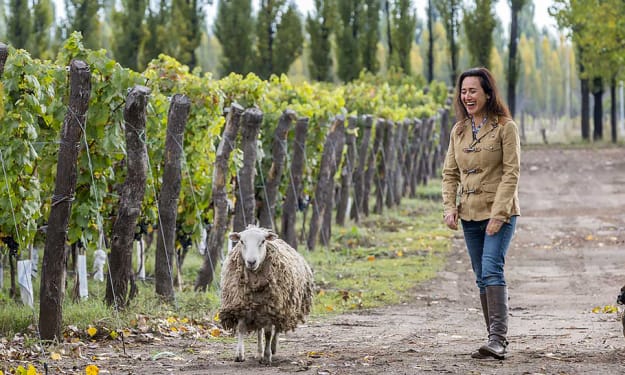Sacramental wine
What is "communion wine" and how is it different from consumer wine?

While wine is enjoyed as a beverage and a food by billions of people every day, it also is an integral part of religious worship. Let’s explore.
Roman Catholic, Eastern Orthodox, and Greek Orthodox churches include wine in every celebration of the Mass. Although viewed differently from a theological point of view, Episcopalians and Lutherans also include wine in their services. Jews use kosher wine in such celebrations as Passover.
So, what is the story behind liturgical or sacramental or kosher wine? Can you use “just any old wine” on the altar or at the seder meal? Heavens, no. There are strict canonical rules governing “fruit of the vine and work of human hands.”
According to Roman Catholic canon law, sacramental “wine must be natural, made from grapes of the vine, and not corrupt.” Eastern Orthodox, Greek Orthodox, and Jewish rules are similar.
There can be a fevered discussion about what “not corrupt” means. Does adding sulfites to preserve wine constitute corruption? Generally, no—sulfites occur naturally in all wine. But what about adding more? Without sulfites, white wines in particular have a shorter shelf life, turn brown and bad. That is real problem for altar wines because they often are stored for months or longer. Thus, blessed be sulfites.
How about adding spirit alcohol to prevent souring or spoilage? You can add away as long as the spirit was distilled from grapes (grape brandy), is added during fermentation—which stops fermentation—and the alcohol level of final product does not exceed 18 percent. If you follow those rules, peace be with you and with your spirits. Also, if congregants are drinking from a common cup, the risk of transmitting sickness is significantly reduced with fortified wine. In the Catholic tradition, drinking from a common cup filled with fortified wine is far, far less dangerous than shaking a pew-mate’s hand during the sign of peace.
Other additives, such as water, juice not from grapes, sugar to boost alcohol during fermentation, alcohol to boost alcohol after fermentation, and anything else? For God’s sake, don’t even think about it. Do that, and you have entered into the dreaded wine corruption zone.
Red, white, rosé/rosato? All are acceptable styles. Sparkling wine? Well, no. Probably hell no.
Makers
Two California companies dominate the Catholic sacramental wine business. Unless you are a priest or church, you cannot purchase sacramental wine in any state except California. In most states there is only one distributor—tax laws and regulations make it prohibitive/impossible for your mom-and-pop liquor-wine-beer store to sell sacramental wine.
Sacramental wine makers are our nation’s oldest wine makers because they were not put out of business by the lunacy of Prohibition. By the 21st century, however, there are only three makers of consequence.
• Mont La Salle Altar Wine Company in Napa https://montlasallealtarwines.com/. Originally part of Christian Brothers, a Catholic religious community, Mont La Salle became a not-for-profit company after the brothers decided to get out of alcohol business in late 1980s.
• Cribari Quality Reserve Altar Wines, Fresno, CA https://altarwine.com/. Cribari’s roots trace to 19th century, their altar wine production to 1917. Cribari produced consumer wines until 1991 when it sold its consumer division to Constellation Brands. The Cribaris kept the sacramental division for the family, and fifth generation Cribaris operate the winery today.
Mont La Salle and Cribari account for 90 percent of U.S. sacramental wine sales.
• O-Neh-Da Vineyard, founded in 1872 in the New York State Finger Lakes region by Catholic Bishop Bernard McQuaid, is the oldest sacramental wine producer still in its original location https://www.onehda.com/about/. O-Neh-Da does not sell west of the Mississippi; its principle markets are in New York, Pennsylvania, and Canada.
All three companies make a variety of wines, from dark red to pale gold. Typical alcohol content is either is 18 percent or 12 percent, but there is a minimum alcohol (0.5 percent) wine called mustum for priests who suffer from alcoholism. High alcohol Angelica—18% ABV—is the best seller. Not only does Angelica taste good in small sips, the alcohol works as preservative, a consideration since many churches purchase only once or twice a year. High alcohol also serves as a disinfectant, important when the Eucharist is from a common cup. Studies show very little transmission of sickness via the shared communion cup with Angelica wine.
General notes
• Sacramental wine is different from consumer or dinner table wine. Different labeling. Different licensing for makers. Different federal and state taxes. That is why wine shops and liquor stores do not carry the product, and why altar wine is not sold to the general public, even direct-to-consumer, by makers, except in California.
The general public can buy wine made to altar wine standards—natural wine made only from grapes, with no additional ingredients—but those will be labeled and taxed as a general consumer product. Typically, the label on such wine might read something like: “Approved for altar use.”
• High alcohol is not required of altar wine. This misconception flows from popularity of Angelica-style wine. Angelica is made by all three sacramental winemakers. It is 18 percent alcohol, the highest permitted by Catholic canon law. Angelica also is popular because it tastes fruity and sweet in small sips.
• All types and colors of wine are used on the altar, from dark red wines such as Mont La Salle Concord, to reddish-pink wines such as Rosato/Rosé, to pale white such as Cribari Chablis or O-Neh-Da’s Haut Sauterne. These examples, by the way, are all 12 percent alcohol, not 18.
• Sacramental wine production was permitted during Prohibition. Sacramental wine sales increased from two million gallons to three million gallons in first two years of Prohibition. Probably not caused by increased number of communicants at Mass services.
What is this stuff in the communion cup?
• What are the little white crystals or flakes in the wine?
Natural grape tartrates that crystallize in wine when it is stored too long or at too cold a temperature. In white wines they are called “wine crystals” or “wine diamonds.” They are more likely to be visible in white wines, but they are more likely to occur in quality red wines (which typically are not used for altar wines). The crystals often form in consumer red wines made old style—no cold fermentation or filtration. In those cases, the crystals are usually signs of quality.
The crystals are harmless. They can be removed by pouring wine through a coffee filter, but best solution is to store the wine properly: a consistent temperature between 55 and 70 degrees. Celebrate the crystals when you decant an old, expensive, non-altar wine from your cellar.
• What are these grains of dark stuff in the wine?
Sediment composed of tannins and other solid matter forms in wine as it ages. They occur in red wines, particularly bottlings aged eight years or more. For quality consumer wines, this is positive sign and can mean wine has promise of character and complexity.
Sediment also is caused by storing wine in hot environment for too long, and in this case it is not a good thing. While sediment is not harmful, in altar wine it usually signals wine is past its prime.
• Why is this white wine brown?
The wine clearly is past its prime. The forces of light and time triumphed over the preservation forces of sulfites. This is serious flaw. The wine can still be consumed—it won’t harm you, but it will taste old. If you are a priest or just a regular wine drinker, when the wine is brown, find the drain and pour it down. The higher alcohol of wines such as Angelica-style tends to prevent this from happening.
About the Creator
Gus Clemens
Nationally-syndicated humorist/wine writer. Gus appears in Gannett USA Today newspapers and several online platforms. Writing professionally since 1969, Gus has authored or participated in 20 books in addition to his humor/wine work.






Comments
There are no comments for this story
Be the first to respond and start the conversation.